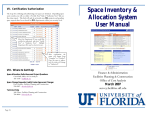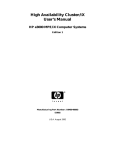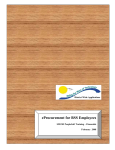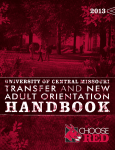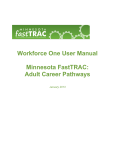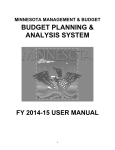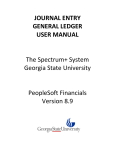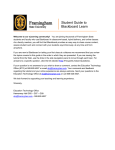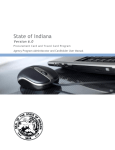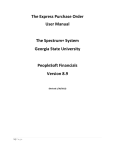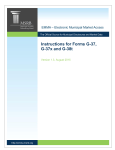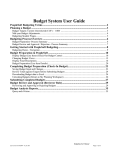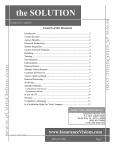Download Space Inventory & Allocation System User Manual
Transcript
Space Inventory and Allocation System User Manual Updated as of June 2015 Cost Analysis PO Box 115350 114 Elmore Hall, Radio Road 352.392-5778 Table of Contents I. Introduction ……………………………………………………………………………………………………………………………….Page 3 Policy for Meeting Deadlines…………………………………………………………………………………………………………Page 3 Getting Started…………………………………………………………………………………………………………………………….Page 4 II. Accessing the Space Inventory and Allocation System………………...…………………………………………………..Page 6 a. Online Security Request b. Recommended System Requirements c. Required Authority Areas III. Main Menu………………………………………………………………………………………………………………………………….Page 7 IV. Room List a. Room Information Screen………………………………………………………………………………………………………..Page 8 b. Space Change Request Screen…………………………………………………………………………………………………..Page 8 c. Add Missing Room Screen………………………………………………………………………………………………………Page 9 d. Occupancy Verification 1. Adding Occupants…………………………………………………………………………………………………………..Page 10 2. Moving Occupants…………………………………………………………………………………………………………..Page 11 3. Copying Occupants………………………………………………………………………………………………………….Page 11 4. Removing Occupants………………………………………………………………………………………………………Page 12 5. Viewing Occupancy History……………………………………………………………………………………………..Page 12 6. Verifying Occupants………………………………………………………………………………………………………..Page 12 e. Space Allocation 1. 2. Entering/Submitting Information…………………………………………………………………………………….Page 13 Definition of Categories………………………………………………………………………………………….Pages 13 - 19 f. Project Verification 1. Adding Projects………………………………………………………………………………………………………………..Page 21 2. Moving Projects……………………………………………………………………………………………………………….Page 22 3. Copying Projects………………………………………………………………………………………………………………Page 22 4. Removing Projects……………………………………………………………………………………………………………Page 22 g. Rooms Designated as 1 - 99% Organized Research 1. Adding a Non-Sponsored Source ….………………………………………………………………………....Pages 23 –24 V. Status Report……………………………………………………………………………………………………………………………..Page 25 VI. Certification/Authorization Process……………………………………………………………………………………………..Page 26 VII. Where to Get Help……………………………………………………………………………………………………………………..Page 26 2 Introduction University of Florida (UF) uses a web-based computer application called Space Inventory and Allocation System to annually collect information on how university buildings and rooms are being utilized. The system has been developed as a joint effort between the Division of Finance and Accounting / Office of Cost Analysis and Planning, Design, and Construction. The information gathered as a result of this survey is used for many purposes. One objective is to assist with development of the Facilities & Administrative (FnA) Rate Proposal to the federal government. Another purpose is to inventory UF space and internally track and monitor how well the University’s space is being used. Finally, data gathered as part of this allocation is also used as a part of the development of the RCM Budgeting tool. There are two processes to reporting space - certifying and authorizing. Different individuals within the department must complete each of these processes. The Office of Cost Analysis requires that authorizers be at the Director, Department Chair, or Dean level. The results obtained through use of the space survey can translate into millions of dollars in funding for the University of Florida. Whether you certify or authorize space for your department, you play a critical role in the University of Florida’s compliance with federal and state guidelines, and its quest to remain competitive with other educational institutions. Policy for Meeting Deadlines The University of Florida is committed to completing its space allocation survey every fiscal year to obtain information necessary for required reporting to the State and for use by the Office of the CFO for the RCM budget process. In addition, completing the space survey every year assists in maintaining the knowledge of staff completing this task. Deadlines are established and communicated for the completion of the space survey which are important for meeting these objectives. Therefore, if a department is noncompliant in meeting these deadlines, all their space will be reported with a use code of “Research Lab” to the Office of the CFO for RCM budgeting purposes. 3 Gathering and Preparing the Information for Input Step I - Before you enter information into the web-based system, you need to become familiar with the space allocation categories. See Space Allocation Survey Category Descriptions on pages 13 through 19 for a complete description of each category. Please remember that your work should be well-documented, include methodology used to determine room allocations. Step II – Interview your room occupants. A feature of the Space Inventory and Allocation Survey is the ability for each department to export to Excel a listing of all the buildings and rooms for which they are responsible. (See Space Inventory and Allocation System/Reports subheading on page 8.) You can then use the Excel worksheet as a tool to interview the occupants and to determine how the space has been utilized. This is the department’s record that the individual and his or her supervisor provided and agreed to the space allocation information. Your department’s authorizer may wish to review the data with you before you enter it into the Space Inventory and Allocation System. You must retain a copy of this information in your office in the event your area is audited. Please call Cost Analysis at 392-5778 if you have any questions about the space allocation categories or which category to use in a specific situation. EXAMPLES When preparing to allocate (spread) the use of a room, the question to be answered is, “Over the entire fiscal year (7/1 to 6/30), how was this space used?” The person responsible for reporting should interview the occupant(s) of a room or a responsible individual (PI, Lab Manager, etc.) in order to determine all uses of the room during the fiscal year. It is important to understand the differences and relationships between effort reporting and space allocation reporting. Effort reporting measures how an individual’s time was used during a specific period. However, when a space administrator interviews occupants of a room, he or she is asking what activities were performed in that space. There is usually a correlation between effort and space reporting, but not necessarily a one-to-one relationship. For example: A professor reported his/her effort for all three semesters of a year as 60% Organized Research, 30% Instruction (including advisement), and 10% Department Administration. This represents the time spent on these activities by the professor. Two rooms are assigned to this professor: an office and a laboratory. After the space administrator interviews the professor, the following is clear: 4 Teaching is performed in classrooms that are allocated by a different department as instruction. The professor’s lab is used 20 hours a week, exclusively for organized research. It is therefore allocated as 100% Organized Research in the Space Inventory and Allocation system. The professor’s office is used approximately 15 hours a week and is estimated by the professor to be used 70% for Instruction, 10% for Organized Research, and 20% for Department Administration. The office is allocated similarly in the Space Inventory and Allocation System. If a Room Has No Occupants Identify the use of the room by talking with the chairperson and/or the people who utilize the room and allocate it accordingly. Example: A departmental mailroom, conference room, and shared equipment room are examples of rooms that may not have assigned occupants. If a Room is Used for Only One Purpose Identify the room use, and allocate it accordingly as 100%. Example: A classroom lab used only for instruction that is funded by appropriations will usually be allocated as 100% Instruction. If a Room is Used for More Than One Purpose (Joint Use) Estimate the percentage of time the room is used for each purpose. This should be based, as stated earlier, on interviews or other documentation. Avoid simply splitting the room 50%-50% or 33%33%-34%, unless this is an accurate representation of how the room was used. Example: If a lab is used for departmental research and organized research, it would be a joint-use room. A faculty member might use his or her office for work related to instruction, departmental administration, and clinical practice. These are examples of a joint use room, and the room should be allocated according to the percentage of each activity performed in the room during the entire fiscal year. If a Room Has Been Vacant or Under Renovation Determine the appropriate percentage of the year that the space was vacant. Normal absences for short work breaks (summer) and vacations do not mean a room is vacant. Also, if the classroom or lab is only used once a week the room is still not listed as vacant and the use of the room would remain 100% Instruction or other correct allocation category. 5 Example: A room that was vacant (empty and unused) for 3 months of the year would be allocated as 25% vacant /renovated and the remaining 75% would be spread under the appropriate categories reflecting how the room was used during the rest of that fiscal year. Remember, the question that must be answered for each space in your survey is, “Over the entire fiscal year, how was this space used?” II. Accessing the Space Inventory & Allocation System a. Online Security Request In order to access the Space Inventory and Allocation System, you will need to have your department’s Security Administrator (DSA) create a security request through myUFL. The DSA will need to enter your UFID, your eight-digit Department ID in the Authority Area, and only one of the following roles: UF_N_IND_COST_SP_ALLOC_BROWSE (a “look only” role) UF_N_IND_COST_SP_ALLOC_CERTIFY UF_N_IND_COST_SP_ALLOC_AUTH. b. Recommended System Requirements Required: Resolution: 1024 x 768 Browser: Microsoft Internet Explorer 7.x or higher or Firefox 3.x or higher Javascript must be enabled Cookies must be enabled c. Required Authority Area field When requesting any space allocation role, please remind your DSA to include the eight-digit DeptID(s) you will be reporting in the Authority Area of the request. If the field is not initially updatable, the DSA must select the Save button to activate the field for input. Examples: ⇒ 29000000 = provides access to all DeptIDs beginning with “29” ⇒ 29010000 = provides access to all DeptIDs with “2901” ⇒ 29010000;29020000;29030000; = access to all DeptIDs beginning with 2901, 2902, 2903 (Note the required semicolons between each and at the end, with no spaces in between.) 6 III. Main Menu Once you have obtained the security role to access the Space Inventory & Allocation System, you will log in using your Gatorlink ID and password. The first screen to appear is the Main Menu. View Selections Users can view their space by building or by department. System Status The status of the system will display on the main menu. When a survey is not in process, the system will be open only for occupancy edits and space change requests. Help If you are in need of assistance with questions, you can click on the link under the Help box to email the Space Team. There is also the User Manual along with a list of Room Use Codes and Allocation Definitions for your convenience. 7 IV. Room List Once you have made your selection, the following screen will be displayed: The room list will display all rooms for the building you have selected with navigation controls at the side of the screen. The list contains building, floor and room numbers, room use, square footage, pending change requests, occupant status symbols, space allocation status symbols, and project information status symbols. a. Room Information Screen Select a row to view the detail screen for the room. This will include the occupants, projects, and allocation percentages of the room. Review the information on this screen for accuracy. If any errors in the room utilization are present, click the submit space change request screen to correct the error. b. Space Change Request Screen If you have the proper security you will be able to update or verify the department who is responsible for the space or the use and sub use of the space. ** Note: If you are not able to click on the button and create a space change request, please refer to page 6 on how to obtain the proper security. 8 This form is used to let Planning Design and Construction know about changes to the room. For example: 1. If the room should not be assigned to your department, check the Wrong Dept? box. If you know which department the room should be assigned to, insert the correct Department ID in the New Dept field. 2. If the Room Use has changed, choose the correct Room Use from the drop down menu. Update the room Sub Use in the same way. 3. If there has been any physical change to the room in the past year, make a note in the Comments field. Planning, Design, and Construction will visit the location and revise the floor plan and square footage information. After completing the Space Change Request, click the Submit button and you will be returned to the room list. A number should now appear in the Pending Requests column indicating how many requests have been made for that room. Certification cannot occur until all Pending Requests have been resolved. c. Add Missing Room Screen If you need to add a room that is missing from your department’s assigned room list, click on Report a Missing Room from the Main Menu under the Tools Heading: 9 d. Occupancy Verification At the start of each survey period, all rooms in the Room List screen (See Page 8) will be marked as needing occupancy verification. After verification of occupants the x listed on the room list screen will change to a check mark. During non-survey periods, occupant changes will still be permitted. The Occupants screen will show all occupants that were reported in the prior year’s Space Inventory and Allocation Survey. Review the occupants who are reported in the room. Occupant information including title and phone number come from HR Job Data. If any of this information is incorrect, contact your department’s personnel to ask about a correction. Adding Occupants To add a new occupant, select ADD. You can search for an occupant using their UF ID, last name or Dept ID. The results are displayed. Use the navigation tools to scroll through the search results until you find the name you are looking for. You will have to add the start date as to the date the individual began occupying the space. 10 Moving Occupants Occupants can be moved from one room to another - without being removed and added again - by using the “MOVE” function. This will remove the occupant from the current room and move them to a new room. Select Occupants Select the occupants you wish to move and select the building and room to which they will be moving. You must also enter the move date in a MM-DD-YYYY format. Once this information has been entered click “MOVE” to complete the move. Copying Occupants Occupants can be copied from one room to another by using the “COPY” function. This is especially useful in instances where a professor and research assistants occupy both an office and one or more laboratories. This function will copy selected occupants of the room to a new room. 11 Removing Occupants To remove an occupant, select the occupants you wish to remove and click on the Remove button. If the occupant shown never occupied the space and needs to be completely removed from this room, change the start date to match the end date in the “History” screen. The date which the occupant was removed will be automatically be entered by the system. Viewing Occupancy History To view the history of a room, select the “HISTORY” function. You can edit the occupant’s start and end dates by clicking on the date you wish to change. Verifying Occupants The final step to Occupancy Verification is to click on the “VERIFY” link. Once you have verified occupants, the icon in the occupants column of the Room List will change from a to a . You are now ready to allocate the space for that room. 12 e. Space Allocation Entering/Submitting Information—Each Space Allocation record will be preset with the icon. This icon indicates that the room needs to be allocated. During non-survey periods the Space Allocation and Project information screens will not be available for input. Click on row of the room to allocate the space. The certifier must allocate the room to one or more of the above categories for a total of 100%. If the total does not equal 100%, an error message will be displayed. Choose the allocation categories using the following definitions: Departmental Administration (DA) Use this category to report space used for administrative and supporting services that benefit common or joint departmental activities or objectives in academic deans’ offices, academic departments and divisions, organized research institutes, study centers, and research centers. Academic deans’ offices: Space attributable to administrative functions. Academic departments: Space attributable to the administrative work (including bid and proposal preparation for new awards) of faculty (including department heads) and other professional personnel conducting research and/or instruction shall be allowed. 13 Includes space used for: • General departmental office functions, including that of a chair and departmental staff, secretarial, clerical, assistants, and administrative officers. • Administrative functions in deans’ offices. • General departmental services, including mail distribution, copy rooms, and telephone service. • Development of bid and proposal for new research activities. • Departmental conference room. Does not include space used for: • Direct administrative effort related to a specific course. That is considered Instruction. • Direct administrative effort related to a specific sponsored project and funded by the sponsored pro- ject. That is considered Organized Research. • Space used for undergraduate or graduate coordination. That space is considered Instruction. General Administration (GA) Use this category to report space used for activities of the general executive and administrative offices of the University and other activities of a general character that do not relate solely to any major function of the institution: i.e., solely to Instruction, Organized Research, Other Sponsored Activities, or Auxiliary/Other Institutional Activities. This category is only for areas that benefit the entire university. Includes space used by: • President’s and vice-presidents’ offices. • Institution-wide financial management, business services, budget and planning, personnel manage- ment, and risk management. • Office of the General Counsel. • UF Bridges. • Finance and Administration. • Central administration of health affairs. • Payroll. Does not include space used for: • Activities within non-university-wide dean’s offices, academic departments, organized research units, or similar organizational units. That space is considered Departmental Administration. 14 Practice Plan Administration (PPA) Use this category to report all space used in support of clinical practice activity, including administrative activities related to the Faculty Practice Plans. Includes space used for: • Administrative and support services for the billing, collection, and distribution of professional fees. • Faculty effort related to scheduling, reviewing patient charts, or other administrative activities related to clinical practice. • Administrative support to faculty for any activity related to clinical practice. Does not include space for: • Actual health care delivery and/or treatment. This is considered Patient Care. Sponsored Project Administration (SPA) Sponsored Project Administration includes space used for all activities performed by Cost Analysis, Contracts and Grants office and the Division of Sponsored Programs. These organizations are designated primarily to administer sponsored projects. Student Administration (STU Adm) Space used for activities for the administration of student affairs and for services to students. Includes: offices of Deans of Students, Admissions, Registrar, counselors, as well as student health and the infirmary. Instruction (INS) Use this category to report space used for all teaching, training, and instructional activities, whether offered for credit toward a degree, certificate, or on a noncredit basis. Includes all activities related to teaching, such as preparation, grading, labs, and assistance to students registered in class. Also includes space for: • Syllabus production, exam preparation, textbook orders, and roster preparation. • Formal classroom teaching. • Academic counseling and advising students. • Course preparation. • Departmental libraries that are not part of the library system. 15 Sponsored Instruction (Spo Ins) Use this category to report space used for specific instructional or other training activities established by a project, contract, or cooperative agreement. Does not include space used for: • Research training, which is considered Organized Research. Departmental Research (DR) Use this category to report space used for research development and scholarly activities that are not Organized Research and, consequently, are not separately budgeted and accounted for. (Typically funds 211 and 212) Includes space used for: • Research-related activities that are funded with unrestricted funds, such as miscellaneous donors, combined projects or allocation of overhead funds, including Gap and Start-Up funding. Organized Research (OR) Use this category to report space used for research and development activities of an institution that are separately budgeted and accounted for. Includes space used for: Sponsored Research. This includes all research and development space used for activities that are sponsored by federal and nonfederal agencies and external organizations. This category includes space used in the training of individuals in research techniques (commonly called “research training”) where such activities utilized the same facilities as other research and development activities and where such activities are not included in the instruction function. Normally these individuals are working on research for projects in Funds 201, 209 or sources in Funds 103 and 221. Examples: Outside Sponsored Research, such as federal, state, or local government; Industry; and Foundations. Please be aware that if a Graduate Assistant or other students occupy a space that is generally 100% Organized Research, you must consider some allocation to Instruction for the time that student may be working on a dissertation, homework, or other class studies. University Research. This includes all research and development space that is sponsored by institutional funds and is separately budgeted and accounted for. This type of organized research is awarded after review of an internal application for support of a specific project. Example: Division of Sponsored Research (DSR) Opportunity Fund projects University of Florida Research Foundation, Inc. projects 16 Other Sponsored Activities (OSA) Use this category to report space used for sponsored projects that are not Organized Research or Sponsored Instruction. These projects are designated by the agency as “Other Than Research.” Examples of such programs include: • Children’s Medical Services. • Mother/Infant Care Services. • Sponsored Museum Exhibits. • Sponsored Journal Editorship. • Sponsored Conference. Agricultural Extension (Ag Ext) Use this category to report activities involving the Institute of Food and Agricultural Sciences’ (IFAS) Cooperative Extension Service. Auxiliary (AUX) Includes space used by: • Residence halls, dining halls, student unions, intercollegiate athletics, bookstores, faculty housing, chapels, theaters, public museums, service centers, and other similar auxiliary enterprises. • Any space area that charges others for a service As well as space used for: • Service Centers/Recharge Centers/Specialized Service Facilities. Other Institutional Activities (OIA) Use this category to report space used for all activities of an institution that are not specifically assigned to other categories. Includes space used by: • Department Break rooms, Department Kitchens, Emeritus Used Space (Non-UF Paid), Volunteer Used Space (Non-UF Paid), Rare book collections, Small Department Libraries, Intercollegiate Activities, Public Relations , Development and fund-raising, Intercollegiate activities Also includes space used for any other function, the activities of which are unallowable per OMB A-21. Governance (Gov) Use this category to report space used for any significant effort devoted to college and university-wide committee assignments. Does not include space used for: • Undergraduate or graduate coordinating/advising, which is considered Instruction. 17 Library (Lib) Use this category to report space used for the operation of the libraries in the official university library system. Library administration should also be reported to this category. Includes space used for: • Storage of books and purchased material of the library. • Reading areas. • Study rooms. • Library administrative room areas. Specifically includes: Library West, Smathers Library, Marston Science Library, Education Library, Journalism Reading Room, Music Library, Architecture and Fine Arts Library, Health Science Center Library, Borland Library (Jacksonville), Map and Imagery Library, Mead Library (P.K. Yonge), Veterinary Medicine Reading Room, and Legal Information Center. Does not include space used for: • Small departmental libraries that are not a part of the official university library system, which are considered Instruction. • Rare book collections, which are reported as Auxiliary/Other Institutional Activities. Operations and Maintenance (O&M) Use this category to report space used for the administration, supervision, operation, maintenance, preservation and protection of the institution’s physical facilities. Includes space used by: • Physical Plant Division (PPD). • Facilities Planning & Construction offices. • Environmental Health & Safety offices. • University Police Department. • Campus Mail. Patient Care Use this category to report any and all space used for clinical practice activity, including the treatment of patients related to the Faculty Practice Plans. 18 Patient Care includes space used for: • Health care delivery and treatment rooms not related to research or instruction. • Patient care rooms (if any are assigned to your department). Does not include space used for: • Administrative and support services for the billing, collection, and distribution of professional fees. • Faculty office space when used for scheduling, reviewing patient charts or other administrative activities related to clinical practice. • Administrative support to faculty for any activity related to clinical practice. These are all considered Practice Plan Administration. Public Service (Pub Svc) Use this category to report space used for assigned duties such as serving as a consultant to local, state or national agencies; serving as an officer in professional societies; acting as an editor for a professional journal. Union Activities (and APA) Use this category to report space used for effort expended on United Faculty of Florida (UFF) or Academic and Professional Assembly (APA) activities. Vacant or Under Renovation (Vac Ren) Use this category to report space that is closed, entirely unused, empty, or undergoing renovation. Space that has been unused during part of the year should be shown at the corresponding percentage that it was vacant. For example: a room that was empty, due to renovation, for three months would be shown as 25% Vacant or Under Renovation on that fiscal year’s Space Allocation Survey. NOTE: Normal absences for short work breaks and vacations do not mean a room is vacant. Also, a room does not have to be used a specified number of hours a week. A dissection room for instruction used three days per week by students and unused the other four days would be allocated as 100% Instruction. 19 f. Project Verification If the room was allocated to Organized Research (OR) or Other Sponsored Activities (OSA), the associated project numbers must be added to the room. In addition, if a room is allocated between 1-99% OR or OSA Federal requirements dictate that you not only designate the sponsored research projects that are occurring within the room, but that you also provide the funding sources (chartfield string) supporting the nonsponsored activities occurring in the room. Both projects and chartfields entered in the previous fiscal year will be shown in the Room Information screen. If a project was not worked on in this space for any part of the current fiscal year, the project should be removed with an end date of June 30, 2013 or earlier. Projects that ended in the fiscal year must still be accounted for. 20 Indicates the date that activity on the project was stopped in this space. Does not indicate the project’s end date. Adding Projects To add a project, select the “ADD” link. You can search for a project using the project number, PI UF ID, Department ID or a title keyword. Active projects are searched by default, change the search criteria to “ALL” if you are looking for a project that ended this fiscal year or a prior fiscal year. A list of projects will be displayed: The projects are grouped by type: Other Sponsored Activity, Organized Research or Departmental Research. Select the project that is being worked on in the room, scroll to the bottom of the list and select “ADD”. More than one project may be added at a time. Enter the start date as to the date that work on the project began in the space and click “ADD” to continue. 21 Moving Projects Projects, just like occupants, can be moved from one room to another - without being removed and added again - by using the “MOVE” function. This will remove the project from the current room and move it to a new room. Copying Projects Projects can be copied from one room to another by using the “COPY” function. This is especially useful in instances where work is being done on a project in more than one location. This function will copy selected projects in the room to a new room. Removing Projects To remove a project, select the project that needs to be removed and click on the “REMOVE” link. If the project listed was never worked on in the space and needs to be removed from the system entirely, enter the same end date as the beginning date. Beginning and ending dates can be found by viewing the “HISTORY” screen. Once the room has had the occupants verified, has been allocated 100% and all appropriate accounts have been added, three blue checkmarks in the top of the Room Information screen should appear indicating this room is complete. 22 g. Rooms Designated as 1 - 99% Organized Research If the room is partially allocated to Organized Research, Federal requirements dictate that you not only designate the sponsored research projects that are occurring within the room, but that you also provide the funding sources (chartfield string) supporting the non-sponsored activities occurring in the room. Adding Non-sponsored Sources Once the sponsored projects have been added to a room that is allocated to Organized Research, you must select the non-sponsored funding sources supporting the other allocations in that room. To do this, click ADD CHARTFIELD. Enter your Dept ID and click “Load HR Accounts” to get a list of all the non-sponsored chartfield strings (based on HR Account Code) for that Department ID. Select and add the desired sources to your room. Alternatively you can select the “Enter a Chartfield” option and manually enter the chartfield you are looking for. 23 Adding Non-sponsored Sources when PeopleSoft ChartFields are not applicable In the drop-down box, there are special selections that can be made to document the non-sponsored allocation(s) when PeopleSoft ChartFields are not applicable. Use these selections to report the non-sponsored portion of a room that has been partially allocated to Organized Research: Not UF-Paid: This can include laboratories and other research space used by students, visiting researchers, Emeritus faculty, and volunteers who are not paid by UF. GA Grant-Funded: Students who are paid by the grant being conducted in the room AND have a desk in the room at which they can work on their own dissertation or other course work. Vacant/Renovated: This can be used if the room has some portion allocated to Organized Research and Vacant/Under Renovation for the fiscal year. 24 V. Status Report The Status Report can be run from the Main Menu or from the link on the bottom menu. The Status Report shows a list of all departments, the number of rooms, and their current status. The certifier’s goal is to have all rooms contain a in the Occupants, Space Allocation and Projects columns. After certification the status will change from “Complete” to “Certified”. Once the space is authorized the status will change All Organized Research and Other Sponsored Activity projects must be accounted for in the Space Inventory & Allocation System before certification can occur. If there are any projects that have not been associated with space, a message will appear indicating how many unreported projects remain. Clicking the “Unreported Projects” will show all projects that still need to be associated with a room. If a project is included on this list in error, please contact the Office of Cost Analysis at 392-5778 for assistance. In addition, all space requests must be completed before certification can occur. If there are any pending space requests that have not been resolved, a message indicating how many pending requests exist will be displayed. Clicking the “Open Space Requests” link will show the user all the pending space requests. If a request shows on this list in error, please contact the Space Management team at 273-4000. 25 VI. Certification/Authorization The steps for certifying and authorizing your space are identical. Depending upon your security you will see either a “Certify Space” link or “Authorize Space” link on the status report. This link will only be activated once ALL projects and pending space requests have been cleared for ALL departments within your security level. Select the Department ID you would like certified or authorized and select “Certify” or “Authorize”. Multiple Department IDs may be selected at once. After certification, the status will change from “Complete” to “Certified”. Once the space is authorized the status will change to “Authorized”. VII. Where to Get Help Space Allocation Definitions and Project Questions [email protected] Cost Analysis, 392-5778 Space Change Requests Planning Design and Construction 273-4000 - [email protected] Technical Help Jodi Chase, Planning Design and Construction 273-4007 - [email protected] 26


























